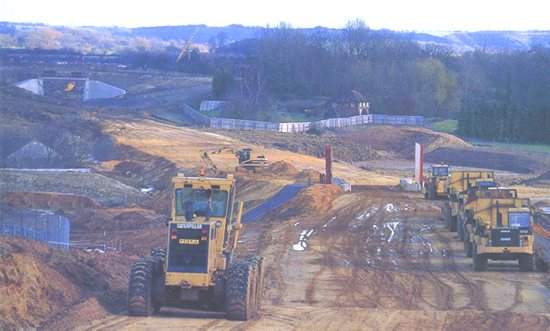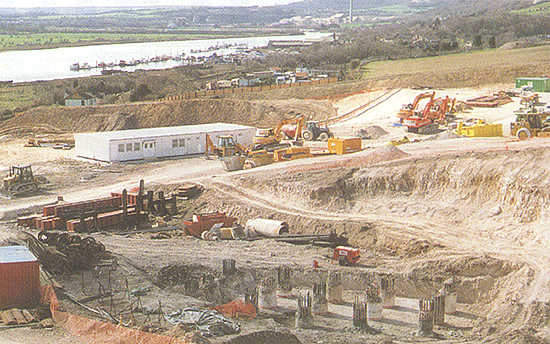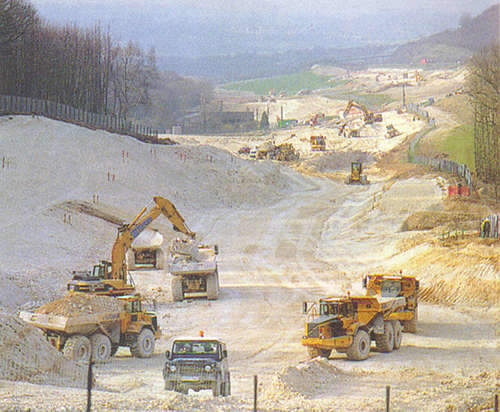High Speed 1, previously known as the Channel Tunnel Rail Link (CTRL), is a 109km-long high-speed rail line in the UK.
Implemented in two sections, the £5.8bn ($9bn) railway line is a French-style LGV high-speed line, linking London with the Channel Tunnel portal at Dollands Moor, near Folkestone. It also caters to domestic passenger traffic.
Section 1 of the project was opened on 28 September 2003. Construction of Section 2 started in July 2001 and was completed in 2007.
The maximum speed on the line is 300km/h, although the speed on the tunnel sections closer to London is limited to 270km/h, and speeds are lower as the trains approach St Pancras.
High Speed 1 is operated and maintained by HS1. A new sustainability strategy was unveiled by HS1 in October 2020 to become the first railway in the UK to run entirely on renewable energy, and achieve its goal of becoming carbon neutral by 2030. The strategy involves procuring rolling stock powered by wind and solar energy.
High Speed 1 project background and concession details
The project was originated by London & Continental Railways (LCR), which was a consortium of design and planning consultancy Arup, engineering firm Bechtel, train and transport operators Virgin and National Express, investment bank SG Warburg, SNCF, London Electricity, Halcrow, and French rail project manager Systra.
Full UK Government approval was granted in 1996 for the two sections of the high-speed line. After 11 years of financial and political turmoil, the project moved forward following the signing of construction contracts by LCR in October 1999.
LCR was nationalised as part of its restructuring due to financial difficulties. The Department for Transport (DfT) assumed ownership of the company in 2009.
The concession for the high-speed line was awarded to Borealis Infrastructure and Ontario Teachers’ Pension Plan by the UK Government in 2010 for a 30-year period until 2040.
A consortium comprising funds managed by InfraRed Capital Partners (InfraRed), including HICL Infrastructure Company and National Pension Service of the Republic of Korea (NPS), and Equitix Investment Management (Equitix), reached an agreement to purchase the concession in 2017.
HICL and Equitix own 35% each in HS1 while NPS holds the remaining interest.
Network Rail (High Speed) is responsible for maintaining and operating the railway infrastructure and three stations, namely Stratford International, St Pancras International, and Ebbsfleet International.
High Speed 1 route details
Section 1 is relatively straightforward and follows existing transport corridors such as the M2 motorway. It extends from the Channel Tunnel to Fawkham Junction (Gravesham), in Kent. Major structures constructed as part of Section 1 included the 1.3km Medway Viaduct (completed in 2002), and the 3.2km North Downs Tunnel.
Section 2 extends from Southfleet to St Pancras, and required large amounts of tunnelling under the River Thames, and under East and North London. The line passes through a 3km tunnel under the River Thames, before running along an extended 1.3km viaduct section under the Queen Elizabeth II M25 bridge, and over the adjacent Dartford Tunnel exit road at Thurrock, in Essex.
After this, the line dives back into tunnel near Dagenham to run for 19km underground through Stratford, emerging above the East Coast Main Line near Holloway Tunnels, close to King’s Cross. The tunnels were dug under the built-up areas of London and 25% of the route runs through a tunnel for a total of 16 miles (25.74km).
High Speed 1 station details
The line includes four stations, namely Stratford International Station, St Pancras International Station, Ebbsfleet International Station, and Ashford International Station.
The underground station at Stratford and a large new depot maintain the Eurostar fleet closer to its home route, replacing the facility at the North Pole in west London, which is difficult to access from St Pancras.
The entire area north and east of St Pancras station was redeveloped, with several new connections to the existing network to allow through working, new connections for Thameslink services, and non-railway development.
Apart from the reconstructed station at Ashford International, Section 1 has no new stations. However, Section 2 has intermediate stations at Ebbsfleet, in North Kent, and at Stratford, in East London.
The St Pancras international station was created by upgrading and expanding the former Midland Railway station as an interchange between Eurostar, domestic CTRL, Midland Mainline, and Thameslink services, and several London Underground lines. It is also convenient for East Coast Main Line services to and from King’s Cross.
Rolling stock
Eurostar trains were introduced to London-Paris/Brussels in November 1994. Built by a consortium led by Alstom, the trains are based on proven technology from French TGV trains. Each train operates using the three different electrical systems used on the railways of Britain, France, and Belgium, which include 750VDC from a third rail, and 25kVAC and 3kVDC from overhead lines, respectively.
Several SNCF-owned sets also have a 1.5kVDC capability for operating in southern and eastern France.
‘Three Capitals’ trainsets comprise two half-sets of one power car and nine intermediate trailers, making a total trainset of 20 vehicles. Bogies within each set are articulated, sharing a two-axle bogie between vehicle ends. They are similar to French TGV sets, but are reduced to UK loading gauge to allow operation over ‘classic’ lines in Britain.
Cars are of monocoque construction while the aerodynamic nose of each power car is made of glass-reinforced plastic with a steel safety cage surrounding the driving position.
Operators and services
Rail companies currently operating along the HS1 route include Eurostar and SE Trains. London South Eastern Railway (LSER) previously operated on the route, however the operation of all Southeastern services was transferred to SE Trains in October 2021. Eurostar operates the international train services to Europe while SE Trains operates domestic services to Kent.
The line also serves freight operating companies. Direct Eurostar services between St Pancras International and Amsterdam commenced in 2018.
A proposal for direct high-speed trains between London and Bordeaux was made in April 2018, as part of HS1’s expansion plans.
Signalling and communications
Eurostar trains operate under five different signalling systems. On the French high-speed lines and in the Channel Tunnel, they use an in-cab system which gives the driver information. If the top speed is exceeded, brakes are automatically applied. The high-speed line also uses French-style TVM430 to control trains, although UK AWS and TPWS are used for operation on classic routes.
Trains are also equipped with KVB receivers, picking up information from trackside transponders along the French high-speed route, again showing the permitted speed to the driver on an in-cab display. A similar system is used in Belgium.
Benefits of HS1 railway line
London to Paris travel time have been cut to two hours 15 minutes, with Brussels possible in two hours, once the whole HS1 line was opened in 2007. The Channel Tunnel portal is just 35 minutes from St Pancras and, from 2009, Kent services began seeing significant reductions, with Ashford taking approximately 36 minutes from London via the CTRL.
The line’s domestic services connect London with Gravesend, Margate, and Broadstairs by joining the classic network at Ebbsfleet while services to Canterbury, Ramsgate, and Dover continue to Ashford to join existing routes.
Contractors involved
Section 2 of the railway line was built by the Rail Link Engineering Consortium, led by Bechtel. The other members of the consortium included Arup, Halcrow, and Systra.
VINCI Construction Grands Projects built a 3km-long single-tube tunnel, a 1.25km-long bridge (including a 305m central span), and a 13.8km-long portion of the first section. The contractual scope also included the construction of two viaducts and 14 engineering structures of different types.
A joint venture (JV) between Alfred McAlpine and AMEC Civil Engineering was contracted to build a 16km-long Section 1. The JB also performed utility diversion works during the second phase of the project.
GrantRail, which rebranded as VolkerRail in March 2009, was awarded a contract for trackwork at Fawkham Junction as part of Section 1.
Westinghouse Signals received contracts to conduct signalling works for both sections of HS1.
Other contractors for Section 1 included Balfour Beatty Major Projects, Skanska Construction UK, J Murphy & Sons, and Hochtief (UK) Construction-Norwest Holst Construction JV.
Skanska Construction UK was also contracted for Section 2. Other contractors who worked on Section 2 included Edmund Nuttall, Kier Construction, Motherwell Bridge Construction, Fujitec, Otis, and Tales Telecommunication Services.











